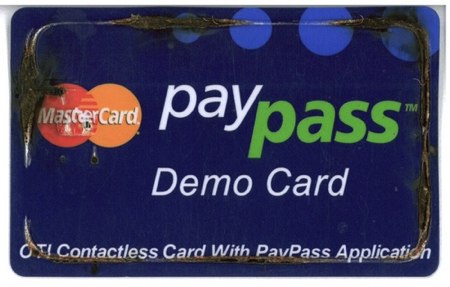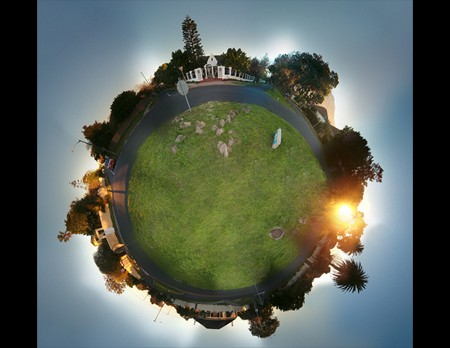
If you’ve got an extra grand laying around, you can pre-order one of [nortd]’s touchkits. It features a unique custom made acrylic screen with a crap ton of IR LEDs embedded in it. An included IR camera provides the input and a projector (you get to supply your own) is used to light the surface. We mentioned this in our multitouch roundup and you can find a video of it embedded after the break.
Day: July 8, 2008
Microwaving RFID Cards

Buzzsurf microwaved an RFID card so you don’t have to. Pointless, but real, unlike those piles of $20s.
[via Synaptic Seepage]
Nokia Haptikos Patent Application Reveals Its Technology

We’ve been waiting for more information on the Nokia Haptikos, the haptic feedback touchscreen announced last October and largely forgotten until now. We knew that it would be a device that could raise sections
of its touchscreen to simulate the feel of buttons or keys, we just weren’t sure how Nokia would pull that off.
Now we have a better idea, as Nokia’s recent patent filing for the Haptikos gives away some juicy details.
The secret behind the device’s feedback is a “plurality of closely spaced voltage controllable protuberances,” or in other words, several small fluid filled compartments just under the screen’s surface. Under them are several piezoelectric members that can be controlled independently; when they extend upward, they apply pressure to the fluid compartments, raising the surface of the screen in that area.
Nokia has yet to work out all the kinks, but you can see the parts that do work by downloading the Haptikos patent application (PDF file).
[via Engadget]
Guide To Creating Small Planets

We at Hackaday often dream of having our own personal planets where we wouldn’t have to deal with other people, but our spaceships aren’t quite ready. While we figure that out, you can do the next best thing: render small planets using Photoshop or GIMP with a few other graphics apps and this guide to making small planets like the one pictured above.
Lively, Google’s Stab At Second Life

Google has just released their own avatar based social arena a la Second Life, which is called Lively. It will require a client download and install like the popular MUD, but after that it can be accessed via IE and Firefox.
Lively allows user to create their own online spaces that can include natural or human-built settings and customize their avatars (which are relatively cartoonish in comparison to SL avatars). Google’s engineering manager for Lively [Niniane Wang] explains that they wanted to create a more socially rich environment than was possible with emotes and other chatroom features.
Lively’s core functions are not particularly novel, but it does innovate with various web integration features. Videos and images from the internet are viewable from within Lively, and users can embed their own personal Lively areas into their blogs or websites (hello VRML).
Lively is not nearly as expansive as Second Life yet, with no form of currency included and only stock items, clothes, avatars, and geometry to choose from. What’s more, it is only available for Windows XP and Vista, with no other OS support announced. We can see this getting better in the future, but those of you who’s lives are so great that you need a second one (or a third) will probably want to jump on this now.
Major DNS Issue Causes Multivendor Patch Day

Earlier this year, our friend [Dan Kaminsky] discovered a major DNS issue that could allow hackers to compromise name servers and clients easily. The vulnerability involves cache poisoning, and [Kaminsky] plans to publish the full details of the vulnerability on August 6th. However, he has already begun his work to control it, alerting major authorities early on of the vulnerability.
As a result, engineers from many major technology vendors quickly began working on coordinated patches for DNS servers. The patches were all released today; vendors and a CERT advisory urge organizations to apply them today, before the vulnerability becomes common knowledge. More details on the DNS issue can be found in the executive overview (PDF file). [Rich Mogull] interviewed [Dan] for the Network Security Podcast. It doesn’t detail the attack but points out that services that use port randomization like OpenDNS are unaffected and that Bind8 is being deprecated.
UPDATE: Here’s the audio from this morning’s press conference.
[image: Flickr / d70focus ]
Pedal Powered Panzer Tank Built For Crashing Parties

A group from Philadelphia PA calling themselves Team pzkpfw decided to recreate a Panzerkampfwagen III, but not entirely according to the original specs. Instead of treads and an engine, they used a system of pedals, gears and chains powered by up to six riders. The team of roughly nine men spent eleven days welding beams and plates, drilling and shaping sprockets, and painting the tank a fearsome pink camouflage. They were planning on crashing the 2nd annual Kensington Kinetic Sculpture Derby with it, which they crashed last year in a pirate ship, but they ended up being too tired from their tooling around to actually do it. There’s always next year. Get a look at their promotional video after the break, or if you’ll be in the Philly area soon, “visit the tank on Frankford Ave, just north of Norris St in Philadelphia.”
Continue reading “Pedal Powered Panzer Tank Built For Crashing Parties”











